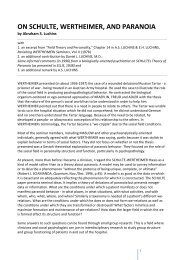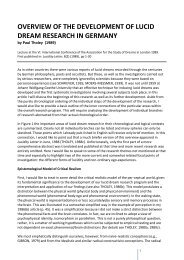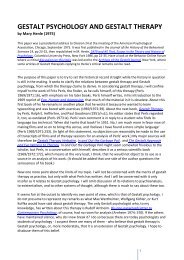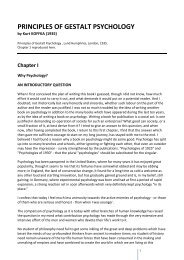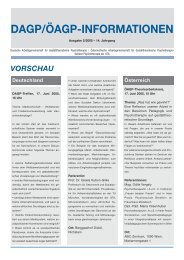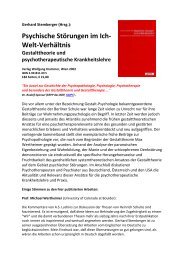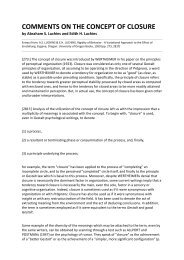234<strong>Gestalt</strong> Theory, Vol. 25 (2003), No. 4With a congruous palm position, a stability advantage of the symmetrical patternas well as a tendency towards symmetry was expected, as <strong>in</strong> KELSO’s (1984) results.This was so because here, as <strong>in</strong> KELSO’s orig<strong>in</strong>al experiment, symmetrical f<strong>in</strong>geroscillation goes together with periodic co-activation of homologous muscle groups.The <strong>in</strong>terest<strong>in</strong>g condition concerned the <strong>in</strong>congruous palm positions, because hereonly the parallel movement mode may <strong>in</strong>volve periodic co-activation of homologousmuscle groups. If there is actually a tendency towards a co-activation of homologousmuscles, then the parallel movement mode should be more stable than the symmetricmode. On the other hand, if there is a tendency towards spatial, and thus perceptual,mirror-symmetry, then the symmetric movement mode should be more stablethan the parallel mode, even though non-homologous muscle groups are periodicallyco-activated.The f<strong>in</strong>d<strong>in</strong>gs by MECHSNER et al. (2001) were straight<strong>for</strong>ward. With congruousas well as <strong>in</strong>congruous palm positions, the mirror-symmetrical movement patternwas more stable than the parallel pattern. Independent of palm positions, spontaneoustransitions from an <strong>in</strong>structed parallel movement <strong>in</strong>to symmetry were observedat <strong>in</strong>creas<strong>in</strong>g oscillation frequencies, but not <strong>in</strong>to the reverse direction. The sameoutcome was revealed if the participants’ view was occluded, thus perception of thehands was restricted to proprioception. MECHSNER et al. concluded that the symmetrytendency is biased towards spatial, perceptual symmetry, without any regardto the <strong>in</strong>volved muscles, or to the correspond<strong>in</strong>g neuronal commands.This is a challeng<strong>in</strong>g result. To be fair, it has been known be<strong>for</strong>e that processes<strong>in</strong> the perceptual functional medium can be powerful enough to br<strong>in</strong>g about spontaneousmovement coord<strong>in</strong>ation phenomena. For <strong>in</strong>stance, two participants look<strong>in</strong>g ateach other will tend to synchronize sw<strong>in</strong>g<strong>in</strong>g limbs as well as sw<strong>in</strong>g<strong>in</strong>g pendulums(SCHMIDT et al. 1990,1998; SCHMIDT & O’BRIEN 1997). Even spontaneous transitionsfrom parallel <strong>in</strong>to symmetrical movements occur. Intrapersonal oscillationsof one hand and one foot tend to adopt a parallel oscillation pattern, <strong>in</strong>dependent of aprone or sup<strong>in</strong>e position of the <strong>for</strong>earm (BALDISSERA et al. 1982). Manipulation ofhaptic feedback can stabilize, but also reverse the preferred coord<strong>in</strong>ation pattern <strong>in</strong> af<strong>in</strong>ger flexion and extension task (KELSO et al. 2001). Such evidence notwithstand<strong>in</strong>git has been argued that <strong>in</strong>trapersonal coupl<strong>in</strong>g of homologous limbs is a specialcase (e.g., SWINNEN et al. 1998), as coupl<strong>in</strong>g of homologous muscles is possiblehere, and <strong>in</strong>deed the reason <strong>for</strong> the symmetry tendency. Until now, there has been noevidence aga<strong>in</strong>st this common claim.MECHSNER et al.’s (2001) results on f<strong>in</strong>ger oscillation demonstrate that there isreason to doubt the role of motoric constra<strong>in</strong>ts <strong>in</strong> br<strong>in</strong>g<strong>in</strong>g about the symmetry tendency.Instead, one may plausibly hypothesize that this tendency is purely perceptual<strong>in</strong> nature. Confirm<strong>in</strong>g results were obta<strong>in</strong>ed <strong>in</strong> the case of a bimanual four-f<strong>in</strong>ger tapp<strong>in</strong>gmodel (MECHSNER et al. 2001), as well as <strong>in</strong> a bimanual wrist oscillation model(MECHSNER et al., submitted). It is worth not<strong>in</strong>g that it seems to be no problem to<strong>in</strong>stantaneously organize the suitable muscular activity that corresponds to the perceptualtendency. The suitable motoric neuronal commands seem to be automaticallyselected and tuned <strong>in</strong>, always adapted to the perceptual movement goal.
Mechsner, <strong>Gestalt</strong> <strong>Factors</strong> <strong>in</strong> <strong>Human</strong> <strong>Movement</strong> Coord<strong>in</strong>ation 235One may speculate that not only spontaneous but also voluntary movement patternsare coord<strong>in</strong>ated directly by way of perceptions and perceptual anticipations,whereas correspond<strong>in</strong>g coord<strong>in</strong>ative processes <strong>in</strong> the motor system are not at allnecessary. In all fairness, <strong>in</strong> say<strong>in</strong>g so I certa<strong>in</strong>ly acknowledge that there are complexpatterns of muscular activity and motoric commands that br<strong>in</strong>g about the movements.However, I assume that such a pattern is not an autonomous entity, which isconceived as such and well organized <strong>in</strong> and of itself. I rather assume that this patternis organized as a by-product of ongo<strong>in</strong>g processes <strong>in</strong> a perceptual functional medium.Compare the motor system to a piano, movements to ongo<strong>in</strong>g music, and theplayer to the perceptual-cognitive system. In order to produce music it is possible tomake use of a player piano or electronic equipment that produces rhythms, harmonies,or even produces fully arranged melodies. On the other hand, one may play anormal piano. In this case the complex activity <strong>in</strong>side the apparatus is not due to thecomplexity of an autonomous <strong>in</strong>ternal configuration, but <strong>in</strong>stead is fully dependenton what the player is do<strong>in</strong>g. I am much <strong>in</strong>cl<strong>in</strong>ed to hypothesize that the motor systemdoes not work like a player piano, thus its activity is fully dependent on what is go<strong>in</strong>gon <strong>in</strong> the cognitive and perceptual functional medium.An experiment on bimanual circl<strong>in</strong>g by MECHSNER et al. (2001) provides additionalevidence. Participants circled two visible flags by way of two cranks, whichwere hidden under the table (Figure 3a). The left flag circled directly above the leftcrank and hand, i.e., <strong>in</strong> exact spatio-temporal correspondence to the hand. The rightflag, however, circled <strong>in</strong> a 4:3 frequency relationship with regard to the right crankand hand, due to a gear system.FIGURE 3: Flag circl<strong>in</strong>g apparatus (a) (see text). Instructed flag movement patters. Mirror-symmetry(b). Antiphase (c). Repr<strong>in</strong>ted by permission from Nature 414: 71 copyright 2001 Macmillan PublishersLtd.After twenty m<strong>in</strong>utes of tra<strong>in</strong><strong>in</strong>g, primarily with the handl<strong>in</strong>g of the right flag, theparticipants were <strong>in</strong>structed to circle the visible flags <strong>in</strong>wards either <strong>in</strong> mirror-symmetryor <strong>in</strong> antiphase (see Figure 3b,c). They were asked to beg<strong>in</strong> at a slow, com<strong>for</strong>tablevelocity and then speed up to a velocity they considered fast, but not beyond the
- Page 6 and 7: 230Gestalt Theory, Vol. 25 (2003),
- Page 8 and 9: 232Gestalt Theory, Vol. 25 (2003),
- Page 12 and 13: 236Gestalt Theory, Vol. 25 (2003),
- Page 14 and 15: 238Gestalt Theory, Vol. 25 (2003),
- Page 16 and 17: 240Gestalt Theory, Vol. 25 (2003),
- Page 18 and 19: 242Gestalt Theory, Vol. 25 (2003),
- Page 20 and 21: 244Gestalt Theory, Vol. 25 (2003),



